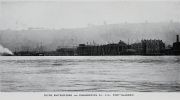Difference between revisions of "Clyde Shipbuilding and Engineering Co"
| Line 30: | Line 30: | ||
==Sources of Information== | ==Sources of Information== | ||
<references/> | <references/> | ||
* L. A. Ritchie, The Shipbuilding Industry: A Guide to Historical Records (1992) | |||
* British Shipbuilding Yards. 3 vols by Norman L. Middlemiss | * British Shipbuilding Yards. 3 vols by Norman L. Middlemiss | ||
* The Engineer of 23rd February 1900. p264 | * The Engineer of 23rd February 1900. p264 | ||
Latest revision as of 11:16, 27 August 2021
of Castle Works, Port Glasgow.
The Clyde Shipbuilding and Engineering Co operated from the Castle yard near Newark Castle in Glasgow, Scotland.
The yard had a long and distinguished history prior to 1900 when the Clyde Company arrived. It had previously been owned by Blackwood and Gordon before closing for two years between 1887 and 1889. There was an attempt by Blackwood to restart the company, but it never really established itself. The Clyde Shipbuilding Co. took over the yard and almost immediately started receiving orders.
Shipbuilding
1900 Clyde Shipbuilding and Engineering Co Ltd was formed with a registered capital of £30,000 to take over Blackwood and Gordon's Castle Street yard, which it then modernised. Mr John Reid, shipbuilder, was in charge of the practical side of the business and Mr Robert Carswell, the commercial department.[1] They built over 100 ships in the following quarter century.
1900s A series of ships were ordered by British, Danish and other countries. The yard also made coastal passenger ships for Australian and British companies
1914 Shipbuilders, Engineers, Boilermakers, Ship and Yacht Repairers. Listed as successors to Blackwood and Gordon. [2]
WWI The yard made standard ships as well as four gunboats.
1919 The yard was taken over by Amalgamated Industrials Ltd which later became part of John Slater Group. The yard moved into a new phase of building even larger vessels.
1920s From 1920-28 the yard made 11 large ships and several Great Lakes traders.
1925 See Aberconway for information on shipbuilding h.p produced in 1904 and 1925
1927 the John Slater Group collapsed and the yard was sold to James Lamont who closed it until 1938.
See Also
Sources of Information
- L. A. Ritchie, The Shipbuilding Industry: A Guide to Historical Records (1992)
- British Shipbuilding Yards. 3 vols by Norman L. Middlemiss
- The Engineer of 23rd February 1900. p264
- Port Glasgow Shipyards [1]


